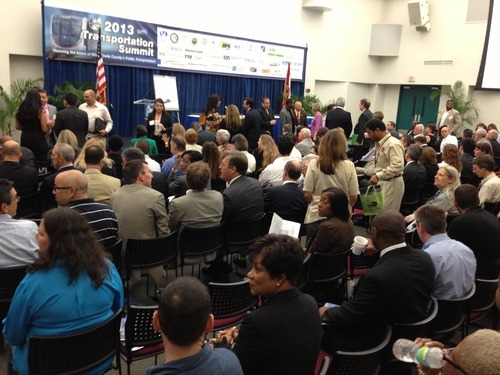Guest Report By Brian Lemmerman

Rarely does a full-day local government-run conference in the middle of a workweek draw such a massive crowd. For that, Miami-Dade County, I applaud thee. The entire event was well-run and administered without technical difficulties. Those are our tax dollars at work.
The full day summit was split into two tracks: an infrastructure/technology track and a financial track, where expert panelists spoke about their niches and responded to public comments. As an urban planner, I opted to attend the infrastructure track. Presentations consisted of 95% background and 5% future visioning. I’m going to focus on the 5%. You can also catch the Twitter conversation at #MDCTransit13 for the next 20 or so days before the hashtag gets gobbled up by the internets.

Miami-Dade County Mayor, Carlos Gimenez set the tone with a case for smart transit, a type of transportation that is not only efficient, but integrates with technology that makes transit readily accessible to everyone. We’re talking about kinetic rail systems and battery-powered bus rapid transit that charges through induction on the highway and can support itself off the highway for miles before returning for a recharge.
MDX’s (Miami-Dade Expressway Authority) chair, Maurice Ferre discussed his vision for retrofitting our existing highway infrastructure with these technologies to make the most of what we already have. Many audience members, including Transit Miami’s Matthew Toro pushed back on this ideal, expressing that we’re perpetuating our reliance on 20th century modes of transportation and outdated ways of thinking.
Citizen feedback was split 50/50 between topics regarding bus/rail, and topics surrounding sustainability/climate change/bicycling. The conversation around climate and cycling, topics scarcely touched on by the experts, generated significantly more audience buzz both in the crowd and on Twitter – often rousing applause. Three times consecutively, however, audience comments (including my own) addressing solar technology incorporation, sea level rise consideration and bicycle intergration were politely dismissed and tabled by the panel moderator in favor of other questions.
In the latter half of the summit, Coconut Grove Collaborative CEO, J.S. Rashid, called for the “reprioritizing of transit solutions in our communities”, expressing that supporting low-income communities with reliable public transportation is essential not only for making economic opportunity equally accessible, but also for saving employers on salary premiums paid out to the car-owning upper-middle class who generally have higher living expenses.
Toward the closing, panelists discussed how leadership drives ridership. A question from Marketing Professional, Francine Madera regarding how often each of the elected officials at the front of the room actively use public transportation revealed that, although some take the bus or MetroRail to work or for weekend excursions a couple days a week, most of the time, they drive.
Takeaways
- The general theme of the conference was Smart Transit with a preface of rehabilitating our existing infrastructure. Miami-Dade Transit Agencies are focused first on giving our highways a consistent experience i.e. all of the exits on the 836 Dolphin Expressway should be on the right. Then, they’re focusing on retrofitting those highways with new technologies for electric or hybrid bus rapid transit systems.
- Miami-Dade County doesn’t yet have canned responses for questions and comments regarding climate change, solar energy or bicycling when it comes to transit, although it was apparent that many of the panelists weren’t closed entirely off from the issues.
- We have to be willing to pay for everything we want. Transit authorities made it clear several times throughout the day that magical transit solutions don’t just appear out of thin air. One of the most hyperbolized quotes of the day:
Everyone wants to go to heaven, but nobody wants to die.
Cool Statistics Mentioned by Panelists
Fact Checking is Encouraged
- A single Miami MetroRail car costs $3 million. A metro mover car costs $2 million.
- Every dollar invested in transit yields $3.5 dollars in wealth for our communities.
- 70% of Miami Transit is subsidized. The U.S. average is 50%.
- 3% of Miami-Dade’s population uses mass transit compared to 13% in New York. When asked who in the room uses Miami’s public transportation, roughly 90% of the hands went up. >> I was just informed that these numbers put out by Maurice Ferre are entirely inaccurate. I will provide an update once I review the data.
What was Accomplished
I’m not exactly sure. Experts gave citizens the vision for the future. Citizens expressed concerns and gave constructive feedback. My hope is that civilian input will be taken into consideration when planning our next 20-30 years of transportation systems.
On another note, a small group of young people were united both in person and via Twitter. Here’s a list of people I interacted with who care deeply about the future of Miami:
- @DaniAmores
- @TitanAdvocacy
- @MIAtransitangel
- @transitmiami
- @MelanieInMiami
- @skrambleon
- @Sustain305
- @MTDot9
- @AleydaKMejia
- @MissSustainable
- @TMStrategies
- @cinera17
Miami-Dade Expressway Authority’s Social Media manager made himself known. This a major development, given that MDX expressed a dire need to jump on social media at their council meeting back in April. His name is Mario Diaz, and can be contacted via Twitter @MDXway. Please be nice and send him informed questions and comments. He has better things to do than answer baseborn 140-character complaints from the uneducated public. He gets those all day and ignores them.
My Thoughts
To guide the conversation away from using automobiles and toward using other forms of transit, I feel that public transportation in Miami needs a full brand overhaul. If we really want people to make that shift, it won’t matter how reliable the bus schedules are or how advanced our new high-speed rail systems get. Taking the bus or the MetroRail today, you feel like a second-rate citizen – most of the time, waiting unshaded along a 6-lane freeway, sitting next to coughing strangers, breathing black diesel exhaust, avoiding the sticky seat, and wondering how those kids etched graffiti into the glass. It’s as though our current transit system was designed without human enjoyment in mind, and it has deteriorated over time as a result. Remember, it costs $3 million for a single MetroRail car.
I think it’s time we make public transportation sexy in Miami.
The way advertisers have managed to make driving sexy. Except we won’t do it with fancy cupholders and all-wheel drive. We’ll do it with unique experiences that driving doesn’t offer.
I had a conversation with Mary Adelyn Kauffman, a musician and doctoral fellow from the University of Miami, who shared with me some of the great transit experiences her travels in Germany had to offer that could work just as well here:
- The Party Bus – a downtown circulator complete with disco ball and music to transport pub crawlers (and other people too).
- Weekend concerts and performances on the train in partnership with local performing arts schools.
- A monthly “Leave Your Car at Home Day” with incentives provided at local events and other venues.
Please share your thoughts and ideas here in the comments.
I also recommend reading this book: “Making Transit Fun! How to Entice Motorists from Their Cars (and onto their feet, a bike, or bus)” by Darrin Nordahl. It’s only $3 if you have a Kindle.

Contact Your Local Transportation People
Boy, would they love to hear something positive for a change! The best way to get in touch with the people in charge of the summit to express transportation concerns is through this Miami-Dade Transportation Trust website page. If anyone can find their Facebook Page, please send me a link, and I’ll post it here.

